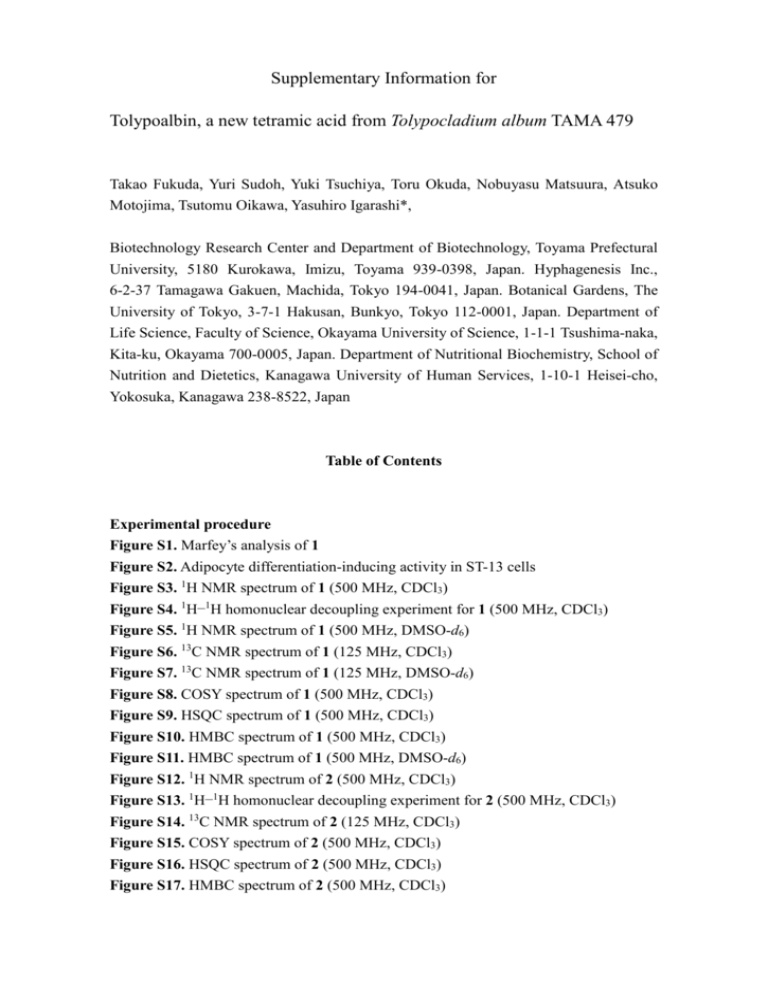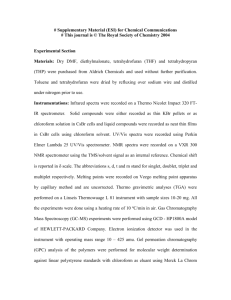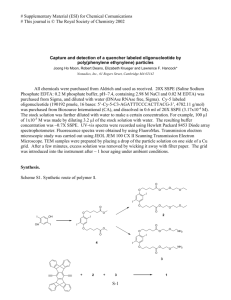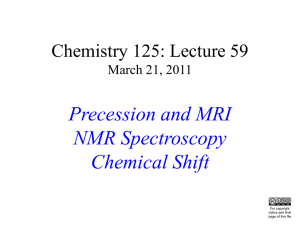Supplementary Information (doc 1190K)
advertisement

Supplementary Information for Tolypoalbin, a new tetramic acid from Tolypocladium album TAMA 479 Takao Fukuda, Yuri Sudoh, Yuki Tsuchiya, Toru Okuda, Nobuyasu Matsuura, Atsuko Motojima, Tsutomu Oikawa, Yasuhiro Igarashi*, Biotechnology Research Center and Department of Biotechnology, Toyama Prefectural University, 5180 Kurokawa, Imizu, Toyama 939-0398, Japan. Hyphagenesis Inc., 6-2-37 Tamagawa Gakuen, Machida, Tokyo 194-0041, Japan. Botanical Gardens, The University of Tokyo, 3-7-1 Hakusan, Bunkyo, Tokyo 112-0001, Japan. Department of Life Science, Faculty of Science, Okayama University of Science, 1-1-1 Tsushima-naka, Kita-ku, Okayama 700-0005, Japan. Department of Nutritional Biochemistry, School of Nutrition and Dietetics, Kanagawa University of Human Services, 1-10-1 Heisei-cho, Yokosuka, Kanagawa 238-8522, Japan Table of Contents Experimental procedure Figure S1. Marfey’s analysis of 1 Figure S2. Adipocyte differentiation-inducing activity in ST-13 cells Figure S3. 1H NMR spectrum of 1 (500 MHz, CDCl3) Figure S4. 1H−1H homonuclear decoupling experiment for 1 (500 MHz, CDCl3) Figure S5. 1H NMR spectrum of 1 (500 MHz, DMSO-d6) Figure S6. 13C NMR spectrum of 1 (125 MHz, CDCl3) Figure S7. 13C NMR spectrum of 1 (125 MHz, DMSO-d6) Figure S8. COSY spectrum of 1 (500 MHz, CDCl3) Figure S9. HSQC spectrum of 1 (500 MHz, CDCl3) Figure S10. HMBC spectrum of 1 (500 MHz, CDCl3) Figure S11. HMBC spectrum of 1 (500 MHz, DMSO-d6) Figure S12. 1H NMR spectrum of 2 (500 MHz, CDCl3) Figure S13. 1H−1H homonuclear decoupling experiment for 2 (500 MHz, CDCl3) Figure S14. 13C NMR spectrum of 2 (125 MHz, CDCl3) Figure S15. COSY spectrum of 2 (500 MHz, CDCl3) Figure S16. HSQC spectrum of 2 (500 MHz, CDCl3) Figure S17. HMBC spectrum of 2 (500 MHz, CDCl3) Experimental procedure General experimental procedure Optical rotations were measured using a JASCO P-1030 polarimeter (JASCO Co., Tokyo, Japan). UV spectra were recorded on a Hitachi U-3210 spectrophotometer (Hitachi, Tokyo, Japan). IR spectra were measured on a Perkin-Elmer Spectrum 100 (Perkin-Elmer Inc., Fremont, CA, USA). NMR spectra were obtained on a Bruker AVANCE 500 spectrometer or Bruker AVANCE 400 spectrometer (Bruker, Rheinstetten, Germany). The 1H and 13C chemical shifts were referenced to the solvent signals (δH = 7.26 and δC = 77.0 in CDCl3; δH = 2.50 and δC = 39.5 in DMSO-d6). HR-ESITOFMS and LC-MS were measured on a Bruker micrOTOF spectrometer. HPLC analyses were carried out on an Agilent 1100 (Agilent Technologies, Santa Clara, CA, USA) using a CAPCELL PAK C18 MGII S5 (Shiseido Co., Ltd., 4.6 × 250 mm). Microorganism The strain TAMA 479 was isolated from a soil sample collected at Machida, Tokyo. The soil was treated by the washing filtration method, and then inoculated on LCA medium (glucose 0.01%, KH2PO4 0.01%, MgSO4・7H2O 0.02%, KCl 0.02%, NaNO3 0.2%, yeast extract (Difco laboratories) 0.02%, agar 2%) supplemented with 0.05% chloramphenicol, 0.0002% cyclosporin and 0.01% tetracycline. This strain was isolated after incubation at room temperature and identified as Chaunopycnis alba W. Gams. (Gams 1980) on the basis of morphological and cultural characteristics and 95-99% similarity of internal transcribed spacer (ITS) sequence (545 nucreotides; GenBank accession number AB987765) to Chaunopycnis alba (accession numbers JN628073, AF389192, JQ272438, HQ608099, HQ608068, HQ608141, KF381088, AF389191, and JN903552). This species was reclassified into the genus Tolypocladium in 2014 and was renamed T. album. Therefore, this strain was identified as T. album. Marfey’s Analysis A solution of 1 (0.5 mg) in ethanolic 1 M HCl (200 μl) was heated at 110 °C for 15 mitutes and evaporated to dryness. The residue was hydrolyzed in 0.5 M KOH (200 μl) at room temparature for 2 h, followed by neutralization with 2 M HCl and lyophilization. The hydrolysate and 1-fluoro-2,4-dinitrophenyl-5-L-leucinamide (1% L-FDLA solution in acetone, 50 μl) were dissolved in 0.1 M NaHCO3 (100 μl). Separately, L-Tyr was dissolved in 0.1 M NaHCO3 (100 μl) and L- or D- FDLA solution. Each mixture was heated at 55 °C for 30 min in a glass tube. After cooling, 0.2 M HCl (50 μl) was added to each tube and then diluted with 50% MeOH/0.2% HCOOH (1:1, 100 μl). The FDLA derivatives were analyzed by LC-MS using a Cadenza CD-C18 reverse-phase column (3 μm, 4.6 × 75 mm, 0.5 ml min-1) at 40 °C with a gradient of MeCN–10 mM NH4HCO3 (MeCN concentration: 25% for 0-10 min, 25-45% for 10-45 min). FDLA derivatives were detected by UV absorption at 340 nm and by selective ion monitoring in the negative ionization mode. The retention times for authentic L- and D-Tyr were 9.4 and 19.2 min, respectively. The FDLA-derivative from 1 was detected at 9.4 min. Biological assays Adipocyte differentiation assay was performed according to the procedure previously described.1 Rosiglitazone, a thiazolidinedione-class antidiabetic agent, was used as a positive control in the adipocyte differentiation assay. It enhanced differentiation in 80% murine ST-13 preadipocyte cells at 0.02 μM. PPARγ agonist assay of 1 and troglitazone was performed in a reporter gene assay (Promega, Madison, WI) according to the manufacture’s instruction. Antimicrobial assy was performed with Escherichia coli NIH-JC2, Micrococcus luteus ATCC9343 and Candida albicans IFO1594 according to the procedures previously described.2 References and notes 1) kunimasa, K., Kuranuki, S., Matsuura, N., Iwasaki, N., Ikeda, M., Ito, A., Sashida, Y., Mimaki, Y., Yano, M., Sato, M., Igarashi, Y., Oikawa, T. Identification of nobiletin, a polymethoxyflavonoid, as an enhancer of adiponectin secretion. Bioorg. Med. Chem. Lett. 19, 2062-2064 (2009) 2) Igarashi, Y., Ogura, H., Furihata, K., Oku, N., Indananda, C., Thamchaipenet, A. Maklamicin, an antibacterial polyketide from an endophytic Micromonospora sp. J. Nat. Prod. 74, 670-674 (2011) Figure S1. Marfey’s analysis of 1 A) FDLA derivatized hydrolysate of 1 2 : 1 a) EIC (m/z 474) b) L-Tyr D -Tyr EIC (m/z 474) 0 10 20 30 40 Time [min] B) FDLA derivatives prepared from hydrolysate of alcohorized 1 a) EIC (m/z 474) b) L-Tyr D -Tyr EIC (m/z 474) 0 10 20 30 40 Time [min] Gradient system of MeCN-10 mM NH3HCO3 (MeCN concentration: A) 25% for 0-5 min, 25-45% for 5-45 min; B) 25% for 0-10 min, 25-45% for 10-45 min); a) Extracted ion chromatogram (EIC) m/z 474 of FDLA-derivatives of 1; b) EIC m/z 474 for FDLA standards corresponding to L- or D-Tyr. C) Two-step degradation of tetramic acid Figure S2. Adipocyte differentiation-inducing activity in ST-13 cells 16 Arbitrary units 12 8 4 0 ROS (20 nM) 40 20 (ROS: rosiglitazone) 10 tolypoalbin (μM) 5 2.5 Figure S3. 1H NMR spectrum of 1 (500 MHz, CDCl3) 9 8 7 6 5 4 3 2 1 ppm Figure S4. 1H−1H homonuclear decoupling experiment for 1 (500 MHz, CDCl3) H-12 H-11 15.0 Hz 15.0 Hz 6.0 Hz irradiation ppm H-12 H-11 CH3-13 ppm H-12 H-11 7 6 5 4 3 2 1 ppm Figure S5. 1H NMR spectrum of 1 (500 MHz, DMSO-d6) 9 8 7 6 5 4 3 2 1 ppm Figure S6. 13C NMR spectrum of 1 (125 MHz, CDCl3) 200 190 180 170 160 150 140 130 120 110 100 90 80 70 60 50 40 30 20 10 0 ppm Figure S7. 13C NMR spectrum of 1 (125 MHz, DMSO-d6) 200 190 180 170 160 150 140 130 120 110 100 90 80 70 60 50 40 30 20 ppm Figure S8. COSY spectrum of 1 (500 MHz, CDCl3) ppm 1 2 3 4 5 6 7 7.5 7.0 6.5 6.0 5.5 5.0 4.5 4.0 3.5 3.0 2.5 2.0 1.5 1.0 ppm Figure S9. HSQC spectrum of 1 (500 MHz, CDCl3) ppm 20 40 60 80 100 120 140 160 8.0 7.5 7.0 6.5 6.0 5.5 5.0 4.5 4.0 3.5 3.0 2.5 2.0 1.5 1.0 ppm Figure S10. HMBC spectrum of 1 (500 MHz, CDCl3) ppm 20 40 60 80 100 120 140 160 180 8.0 7.5 7.0 6.5 6.0 5.5 5.0 4.5 4.0 3.5 3.0 2.5 2.0 1.5 1.0 200 ppm Figure S11. HMBC spectrum of 1 (500 MHz, DMSO-d6) ppm 20 40 60 80 100 120 140 160 180 10 9 8 7 6 5 4 3 2 1 200 ppm Figure S12. 1H NMR spectrum of 2 (500 MHz, CDCl3) 7.5 7.0 6.5 6.0 5.5 5.0 4.5 4.0 3.5 3.0 2.5 2.0 1.5 1.0 ppm Figure S13. 1H−1H homonuclear decoupling experiment for 2 (500 MHz, CDCl3) H-12 H-11 15.3 Hz 15.3 Hz 6.1 Hz irradiation ppm H-12 H-11 CH3-13 ppm H-12 H-11 7 6 5 4 3 2 1 ppm Figure S14. 13C NMR spectrum of 2 (125 MHz, CDCl3) 210 200 190 180 170 160 150 140 130 120 110 100 90 80 70 60 50 40 30 20 ppm Figure S15. COSY spectrum of 2 (500 MHz, CDCl3) ppm 1 2 3 4 5 6 7 7.5 7.0 6.5 6.0 5.5 5.0 4.5 4.0 3.5 3.0 2.5 2.0 1.5 1.0 ppm Figure S16. HSQC spectrum of 2 (500 MHz, CDCl3) ppm 20 40 60 80 100 120 140 8.0 7.5 7.0 6.5 6.0 5.5 5.0 4.5 4.0 3.5 3.0 2.5 2.0 1.5 1.0 ppm Figure S17. HMBC spectrum of 2 (500 MHz, CDCl3) ppm 20 40 60 80 100 120 140 160 180 200 7.5 7.0 6.5 6.0 5.5 5.0 4.5 4.0 3.5 3.0 2.5 2.0 1.5 1.0 0.5 ppm










